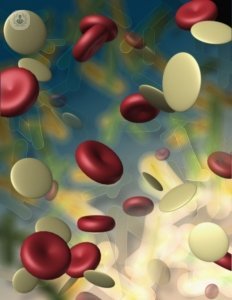Meet the Von Willebrand disease, pathology coagulation deficit
Written by:Von Willebrand disease is an inherited blood disorder that causes a deficiency in clotting. This makes patients who suffer from bleeding more often or bruising or bruising them appear more frequently. It must study well the case and the type of von Willebrand Disease to provide proper treatment.

Von Willebrand disease: what is
Von Willebrand's disease is a disease of hereditary clotting that prevents blood from clotting properly, causing patients have spontaneous tendency or, in certain situations of hemorrhagic risk to cause bleeding. It is undoubtedly the most common coagulopathy with a prevalence of 1-2% of the population and, unlike Hemophilia can affect both men and women. It was first described in 1926 thanks to Dr. Erik von Willebrand.
How Von Willebrand disease occurs?
Normally when a bleeding due to rupture of a blood vessel by a wound occurs the platelets plug the hole in the vessel to prevent further blood out. Using the calcium, vitamin K and a number of plasma proteins called clotting factors, in particular, the factor I which is fibrinogen, platelets produce a "network" for the formed cap remains stable in its site in order to close the wound. When this dries and hardens mesh forms a scab to protect the wound while closing.
Blood is a protein known as von Willebrand factor, which helps platelets to stick or added to the damaged portions of the blood vessel. Furthermore, this factor is also involved in the proper transport of other coagulation factors, namely factor VIII, whose deficit produces the kind of Haemophilia more frequent or type A.
Thus patients with von Willebrand disease have bleeding problems because the levels or function of these blood components needed for clotting are abnormal.
Types of Von Willebrand disease
Traditionally three types of disease, the type of alteration depending on clotting protein known to occur:
• Type 1: the patient has less amount of von Willebrand factor in the blood of normal. Although this disease can worsen with taking aspirin and other nonsteroidal antiinflammatory drugs (NSAIDs), or in situations of hemorrhagic risk, such as surgery or trauma, symptoms generally can be so mild that it is possible that the affected person never becomes diagnosed. Usually causes spontaneous bleeding. It is the most common type and milder form of the disease.
• Type 2: In this type the body makes abnormal von Willebrand factor, which obviously creates problems of coagulation. In this case as bleeding bruising skin and mucous membrane may itself be spontaneous.
• Type 3: There is a manufacturing defect, both von Willebrand factor and factor VIII transporting or factor. Concentrations of both coagulation factors in serum of patients is virtually undetectable. The incidence of spontaneous bleeding both superficial (skin and mucosa) and deep (affecting certain types of organs or joints), is high.
There are cases of von Willebrand pseudodisease of von Willebrand acquired disease of where the operation is abnormal platelet. This makes the von Willebrand factor sticking too well, causing coagulation disorders and bleeding tendency, either low or low blood platelet factor concentration in the patient serum. This has been seen in certain types of blood disorders, such as amyloidosis, multiple myeloma, macroglobulinemia Waldestron or by eating certain types of drugs such as antihypertensives, immunosuppressants, antibiotics or oral hypoglycemic agents, among others. The clinical impact of this phenomenon in the form of superficial bleeding both skin and mucous membrane is very mild and resolves controlling the condition or situation that causes base.
Von Willebrand disease , a hereditary disease
As in hemophilia, von Willebrand disease, is a genetic disorder that is passed from parent to child, so that the son of a man or woman with the disease has a 50% chance of inheriting the gene affection. In types 1 and 2 offspring has inherited the gene from one parent or the mother or father, while in type 3 necessarily the child has inherited the genetic alteration of the parents.
Signs and symptoms of von Willebrand disease
Von Willebrand's disease includes the following signs and symptoms:
- Marked tendency to bruising or bruising- Menses copious or other abnormal bleeding, if women of childbearing age- Tendency to bleeding gums, nose or intestinal mucosa- Hemorrhages it takes to coagulate to injuries, cuts or bleeding for too long after tooth extractions or undergo other surgical intervention
Diagnosis of Von Willebrand Disease
As in any hematologic process, medical history is essential to find family or personal history frequent bleeding. The systematic physical examination will help the expert in hematology to detect outbreaks or bleeding lesions.
As for specific laboratory tests that will help us detect the type of von Willebrand disease is precise:- The determination of clotting times- Test of platelet aggregation- Determination of the concentrations of von Willebrand factor, factor VIII and patient blood platelets
Sometimes it is necessary to repeat the tests several times because the concentrations of these components may vary in a physiologically person throughout life, for example, with age or during pregnancy.
Treatment and life expectancy of Von Willebrand Disease
Quality of life, especially for patients with type 1 disease, which is the most common, is similar to that of the population does not affect. Teenagers afflicting the most serious types of pathology must refrain from extreme sports or contact such as football, hockey, martial arts or boxing, as happens with haemophilia, in order to avoid injury or unnecessary bumps .
In the case of bleeding occur, simply plug for a while the affected area to stop bleeding. Paras girls of menstruating age sometimes contraceptives or antifibrinolytic treatments prescribed to treat excessive bleeding.
When these measures are not effective, other treatments such as desmopressin may be necessary, useful only in type 1 and some types 2 disease. This substance causes a temporary increase in blood concentration factor. It can be administered intranasally or by intravenous infusion and is useful to prevent bleeding at risk, such as surgery or tooth extraction.
For other types 2 and 3 of the pathology where this drug has no effect, they need to be treated with drugs as in haemophilia, containing both the factor VIII and the von Willebrand factor. These types of drugs are administered intravenously.


